What can-you-do完整版
Unit4Whatcanyoudo(1) -完整版教学设计
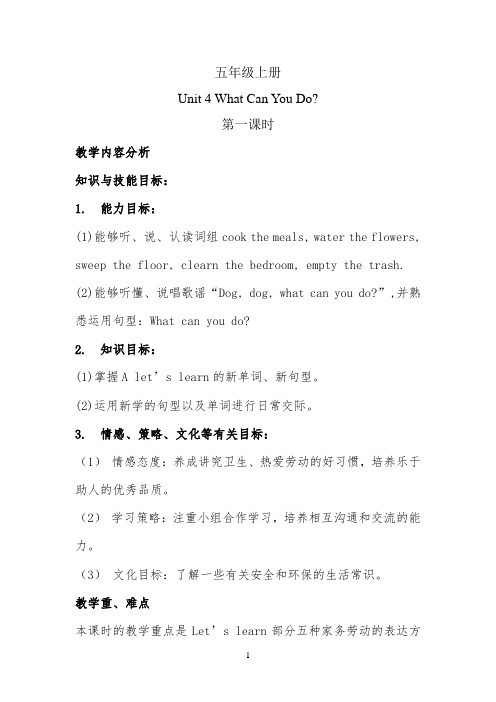
五年级上册Unit 4 What Can You Do?第一课时教学内容分析知识与技能目标:1. 能力目标:(1)能够听、说、认读词组cook the meals, water the flowers, sweep the floor, clearn the bedroom, empty the trash. (2)能够听懂、说唱歌谣“Dog, dog, what can you do?”,并熟悉运用句型:What can you do?2. 知识目标:(1)掌握A let’s learn的新单词、新句型。
(2)运用新学的句型以及单词进行日常交际。
3. 情感、策略、文化等有关目标:(1)情感态度:养成讲究卫生、热爱劳动的好习惯,培养乐于助人的优秀品质。
(2)学习策略:注重小组合作学习,培养相互沟通和交流的能力。
(3)文化目标:了解一些有关安全和环保的生活常识。
教学重、难点本课时的教学重点是Let’s learn部分五种家务劳动的表达方法,要求学生做到四会,并能在情景中自然的加以运用。
教学难点是如何利用所提供的对话和情景,以旧引新,让学生进入学习状态。
课前准备1.教师准备教学过程中所需要的图片、头饰、英文卡片、课件。
2.教师准备录音机及录音带。
教学流程与设计意图:Step 1: warm up1.GreetingT: Good afternoon.S:Good afternoon.2.Listen to the chart请同学听”Chant”使学生对于今天所学的内容有初步的了解设计意图:这个环节学生对于”Chant”的韵律很感兴趣,很容易跟读,为今天所学内容做铺垫。
Step 2: Presentation1.Let’s learn1)请同学看老师,教师边做动作边提问:What can I do? 学生见教师在扫地会说“扫地”,教师引出 sweep the floor.请每组学生用升降来说词组,请单个学生读,教师帮助纠音,教师做浇花动作再引出词作 water the flowers.做倒垃圾动作引出 empty the trash.2)学生看课件学习 clean the bedroom, cook the meals3)Let’s do教师发指令学生听到后重复并快速做出动作。
unit-4-what-can-you-do教案
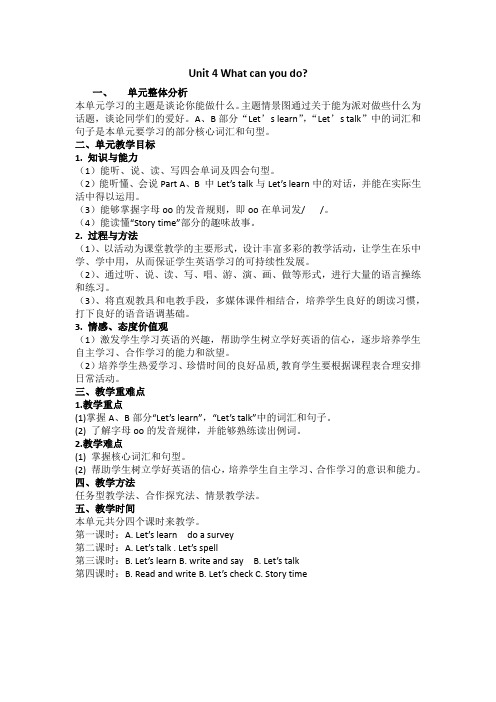
Unit 4 What can you do?一、单元整体分析本单元学习的主题是谈论你能做什么。
主题情景图通过关于能为派对做些什么为话题,谈论同学们的爱好。
A、B部分“Let’s learn”,“Let’s talk”中的词汇和句子是本单元要学习的部分核心词汇和句型。
二、单元教学目标1. 知识与能力(1)能听、说、读、写四会单词及四会句型。
(2)能听懂、会说Part A、B 中Let’s talk与Let’s learn中的对话,并能在实际生活中得以运用。
(3)能够掌握字母oo的发音规则,即oo在单词发/ /。
(4)能读懂“Story time”部分的趣味故事。
2. 过程与方法(1)、以活动为课堂教学的主要形式,设计丰富多彩的教学活动,让学生在乐中学、学中用,从而保证学生英语学习的可持续性发展。
(2)、通过听、说、读、写、唱、游、演、画、做等形式,进行大量的语言操练和练习。
(3)、将直观教具和电教手段,多媒体课件相结合,培养学生良好的朗读习惯,打下良好的语音语调基础。
3. 情感、态度价值观(1)激发学生学习英语的兴趣,帮助学生树立学好英语的信心,逐步培养学生自主学习、合作学习的能力和欲望。
(2)培养学生热爱学习、珍惜时间的良好品质, 教育学生要根据课程表合理安排日常活动。
三、教学重难点1.教学重点(1)掌握A、B部分“Let’s learn”,“Let’s talk”中的词汇和句子。
(2) 了解字母oo的发音规律,并能够熟练读出例词。
2.教学难点(1) 掌握核心词汇和句型。
(2) 帮助学生树立学好英语的信心,培养学生自主学习、合作学习的意识和能力。
四、教学方法任务型教学法、合作探究法、情景教学法。
五、教学时间本单元共分四个课时来教学。
第一课时:A. Let’s learn do a survey第二课时:A. Let’s talk . Let’s spell第三课时:B. Let’s learn B. write and say B. Let’s talk第四课时:B. Read and write B. Let’s check C. Story time第一课时教学目标知识与能力(1). 能听、说、读、写单词和词组sing English song,play the pipa, do kung fu, dance draw cartoons。
What-can-you-do-BLet's-talk教学设计案例
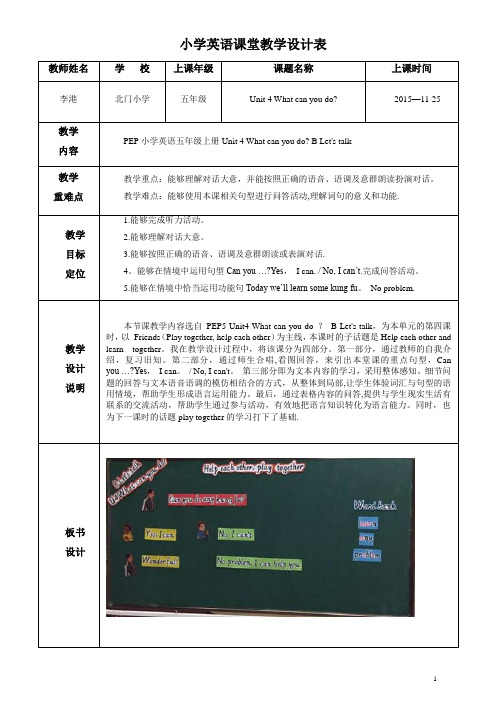
小学英语课堂教学设计表教师姓名学校上课年级课题名称上课时间李港北门小学五年级Unit 4 What can you do? 2015—11-25教学内容PEP小学英语五年级上册Unit 4 What can you do? B Let's talk教学重难点教学重点:能够理解对话大意,并能按照正确的语音、语调及意群朗读扮演对话。
教学难点:能够使用本课相关句型进行问答活动,理解词句的意义和功能.教学目标定位1.能够完成听力活动。
2.能够理解对话大意。
3.能够按照正确的语音、语调及意群朗读或表演对话.4。
能够在情境中运用句型Can you …?Yes,I can. / No, I can’t.完成问答活动。
5.能够在情境中恰当运用功能句Today we’ll learn some kung fu。
No problem.教学设计说明本节课教学内容选自PEP5 Unit4 What can you do ? B Let's talk,为本单元的第四课时,以Friends(Play together, help each other)为主线,本课时的子话题是Help each other and learn together。
我在教学设计过程中,将该课分为四部分。
第一部分,通过教师的自我介绍,复习旧知。
第二部分,通过师生合唱,看图回答,来引出本堂课的重点句型,Can you …?Yes,I can。
/ No, I can't。
第三部分即为文本内容的学习,采用整体感知、细节问题的回答与文本语音语调的模仿相结合的方式,从整体到局部,让学生体验词汇与句型的语用情境,帮助学生形成语言运用能力。
最后,通过表格内容的问答,提供与学生现实生活有联系的交流活动,帮助学生通过参与活动,有效地把语言知识转化为语言能力。
同时,也为下一课时的话题play together的学习打下了基础.板书设计表格详见下页:Can you do it?1. 看看下面这些你们都会吗,打√或打×。
外研版七年级下册英语Module2Whatcanyoudo(及答案)

外研版七年级下册英语Module2Whatcanyoudo(及答案)外研版英语七年级下册Module 2 What can you do?◎第1课时Unit 1 I can play the piano.⼀、根据句意及图画提⽰完成单词。
1. My sister often plays the _______after school.2. Tony __________ a bike to school every day.3. My mother __________English in a middle school.4. —Can Tom play__________?—Yes, he can play very well.5. —What’s on the__________?—Let’s go and see.⼆、⽤括号内所给词的适当形式填空。
1. Ted can_________(speak) English well.2. DaMing would like __________(join) the music club.3. What about _________(he)?4. Ling Ling teachers really___________(good).5. We can teach __________(they) Chinese.三、句型转换1. Her brother can play basketball and table tennis. (改为否定句)Her father _______ _______ basketball ________ table tennis.2. Lily can dance well. Can you dance well? (改为同义句)Lily can dance well. ________ ________ you?3. Don’t be worried about me. (改为同义句)Don’t ________ ________ me.4. Mary can play basketball well. (改为⼀般疑问句并作肯定回答)—________ Mary ________ basketball well?—________, she________.5. He wants to join the Dance Club. (改为同义句)He ______ _______ _______ join the Dance Club.四、根据汉语意思完成下列英语句⼦,每空⼀词。
unit-4-《What-can-you-do-》说课稿说课稿
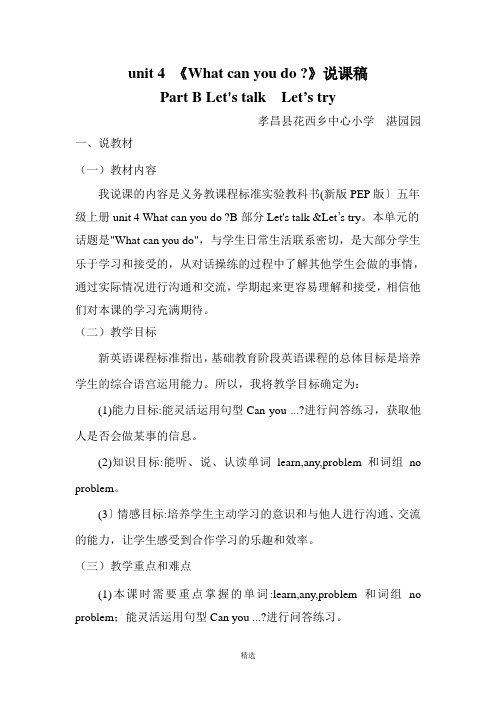
unit 4 《What can you do ?》说课稿Part B Let's talk Let’s try孝昌县花西乡中心小学湛园园一、说教材(一)教材内容我说课的内容是义务教课程标准实验教科书(新版PEP版〕五年级上册unit 4 What can you do ?B部分Let's talk &Let’s try。
本单元的话题是"What can you do",与学生日常生活联系密切,是大部分学生乐于学习和接受的,从对话操练的过程中了解其他学生会做的事情,通过实际情况进行沟通和交流,学期起来更容易理解和接受,相信他们对本课的学习充满期待。
(二)教学目标新英语课程标准指出,基础教育阶段英语课程的总体目标是培养学生的综合语宫运用能力。
所以,我将教学目标确定为:(1)能力目标:能灵活运用句型Can you ...?进行问答练习,获取他人是否会做某事的信息。
(2)知识目标:能听、说、认读单词learn,any,problem和词组no problem。
(3〕情感目标:培养学生主动学习的意识和与他人进行沟通、交流的能力,让学生感受到合作学习的乐趣和效率。
(三)教学重点和难点(1)本课时需要重点掌握的单词:learn,any,problem和词组no problem;能灵活运用句型Can you ...?进行问答练习。
(2)词组no problem的使用是本课时的难点,要让学生在课堂上较好掌握该词,教师需巧教.趣教.努力调动学生积极性。
二、说教法根据以上对教材的分析我采用情景法、游戏法、对话法、多媒体辅助法等教学方法,坚持以话题为核心。
以功能、结构为主线,以任务型活动安排本课,从学生会做的事情着手,创设英语学习氛圈围,激发学生的学习兴趣,让学生在参与活动中,掌握知识,发展能力。
三、说教学过程。
1、Warm-up课堂口语练习。
(通过口语对话练习,调动学生的学习积极性,将思维转到英语上来。
外研版七年级下册英语Module2Whatcanyoudo知识点及练习(有答案)
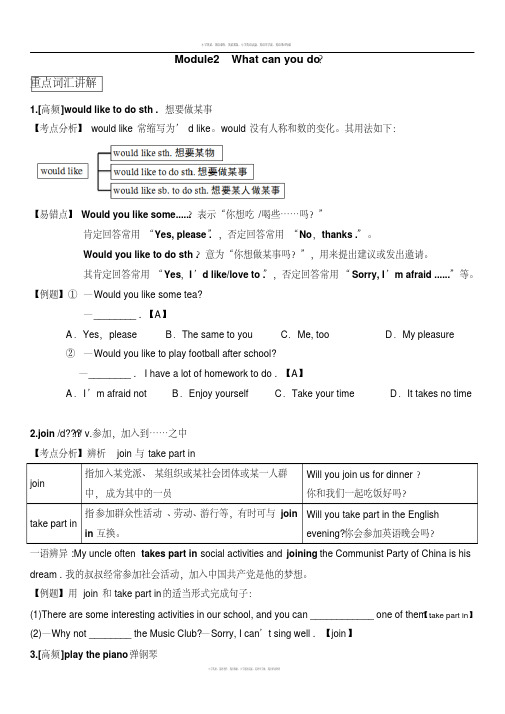
Module2 What can you do?重点词汇讲解1.[高频]would like to do sth .想要做某事【考点分析】would like常缩写为’d like。
would没有人称和数的变化。
其用法如下:【易错点】Would you like some......?表示“你想吃/喝些……吗?”肯定回答常用“Yes, please .”,否定回答常用“No,thanks .”。
Would you like to do sth .?意为“你想做某事吗?”,用来提出建议或发出邀请。
其肯定回答常用“Yes,I’d like/love to .”,否定回答常用“Sorry, I’m afraid ......”等。
【例题】①—Would you like some tea?—________ . 【A】A.Yes,please B.The same to you C.Me, too D.My pleasure②—Would you like to play football after school?—________ . I have a lot of homework to do . 【A】A.I’m afraid not B.Enjoy yourself C.Take your time D.It takes no time2.join /d???n/ v.参加,加入到……之中【考点分析】辨析join与take part injoin 指加入某党派、某组织或某社会团体或某一人群中,成为其中的一员Will you join us for dinner?你和我们一起吃饭好吗?take part in 指参加群众性活动、劳动、游行等,有时可与joinin互换。
Will you take part in the Englishevening?你会参加英语晚会吗?一语辨异:My uncle often takes part in social activities and joining the Communist Party of China is his dream . 我的叔叔经常参加社会活动,加入中国共产党是他的梦想。
Unit4WhatcanyoudoALet'sspell教案 【完整版】

Unit4Whatcanyoudo?PartALet’sspell学习目标1.通过大量的听读操练,掌握短元音/u/和长元音/u:/在单词中的发音,培养学生主动探索单词发音规律的意识。
2.培养学生辨别相似发音的能力。
3.着重培养学生的听力能力和学习英语的兴趣。
学习重难点1.通过大量的听读操练,掌握短元音/u/和长元音/u:/在单词中的发音,培养学生主动探索单词发音规律的意识。
教学难点短元音/u/和长元音/u:/的发音不易区分,要帮助学生理解并反复操练。
教学过程一、课前热身(Warm-up)1.FreetalkT:Goodmorning,everyone.Ss:Goodmorning,teacher.T:Howareyoutoday?Ss:Fine,thankyou.2.教师请一两组学生上讲台表演“B.Let’stalk”部分对话。
二、课前预习(Preview)1.学生向同桌介绍自己喜爱的卡通人物会做些什么事情,然后教师请几名学生向全班同学介绍。
2.我说你做教师向全班学生发出指令,如:playbasketball,swim…全班学生根据教师的指令做相应的动作。
三、新课呈现(Presentation)A.Let’sspell1.Read,listenandchant(1)Let’stalk表演后,提问WhatcanZhangPengdo?S:HecansingEnglishsongs.再呈现第二单元中ZhangPeng踢足球的图片,继续提问,由此引出football。
(2)再呈现ZhangPeng在公园中踢足球遇到Sarah在看书的场景图,并提问What’sthat?回答It’sastorybook.引出book。
(3)由football与book引出oo发短音/u/。
并请同学来拼读。
(4)同学拼读非常棒,课件出现许多彩色气球以示鼓励。
引出balloon。
并由Balloons!Cool!引出cool,并总结oo发长音/u:/(5)请同学来一起拼读。
Unit 4 What can you do 优质课公开课教案

Unit 4 What can you do 优质课公开课教案Unit 4 优质课公开课教案本节课教学目标:学生能够掌握针对各种日常活动和技能的问答和表达方式,并能够在真实情境中运用这些句型。
本节课将通过听力、口语和阅读三个环节,激发学生的学习兴趣,提高他们的英语沟通能力。
一、教学准备1. 教学用具:投影仪、课件、录音机2. 学生用具:学生手册、笔、笔记本二、教学过程A. Warm-up1. Greetings and roll call.2. Review what students learned in the last lesson by asking questions.B. Listening practice1. Play the recording of a conversation between two people talking about their abilities.2. Students listen and answer the questions in their textbooks.3. Go through the answers as a class and clarify any questions or difficulties.C. Speaking practice1. Divide students into pairs.2. Give each pair a stack of activity cards with different abilities written on them.3. Students take turns asking and answering questions about what they can do using the language in the textbook.4. Monitor the students and provide feedback on their pronunciation and sentence structure.D. Reading practice1. Introduce a short passage about a person talking about their daily activities.2. Ask students to read the passage silently and underline any words or phrases they don't understand.3. Discuss the passage as a class, making sure students understand the meaning and context of the text.4. Ask comprehension questions to ensure students have understood the passage.E. Extension activity1. Divide the class into small groups and assign each group a different skill or activity.2. Each group works together to create a short dialogue or role-play based on their assigned skill or activity.3. Groups perform their dialogues or role-plays in front of the class.4. Teacher gives feedback on pronunciation, fluency, and sentence structure.F. Wrap-up1. Recap the main points covered in the lesson.2. Assign homework to reinforce the concepts learned in class.三、作业1. Review the vocabulary and sentence patterns from the lesson.2. Write a short paragraph describing an activity or skill that you can do well.通过听力练习、口语练习和阅读练习的方式,本节课旨在帮助学生掌握一些关于日常活动和技能的表达方式,并能够在实际情境中灵活运用。
外研版七下M2u3《What-can-you-do》ppt课件

4.He___i_s__ _g_o_o_d___ __a_t___ (擅长)football.
5. 6. 7. 8.
_IHIE’__e_v_d___e___lrg_i__ky___ee__b_tt__oso___d__b_o__ye_n___t_((h每保e_w个c_证l_ae人_)sl_stl)o_i_h_s_w_eh_l_epi__tr_mh_ye_(?o相_ou_.n处_i_t融_o_r洽(班)e长ve)r.yone
Module 2 what can you do?
Unit 3 Language in use
单词拼写
1. I want to join the music ______c__lu(俱b乐部).
2. Tony can ____p__la_y___t_h_e___p_i_a_n_(o弹钢琴).
3.He’d like to be the ______P__E___m__o__n_it(o体r育委员).
4. What’s the girl’s father’s name? ( )
E
5. Can she speak Chinese? ( )
D
A. Twelve. B. A student. C. America. D. No, she can’t.
E. His name is Tony Green.
Look at the pictures. Say what Daming and you can do and can’t do.
1. _C_a_n_ Daming play football? _Y_e_s_, he___c_a.n I____ play football.
2. _C__a_n Daming swim? _Y_e_s_, he___c_a.nI____ swim.
Unit4WhatcanyoudoALet'slearn -完整版教学设计
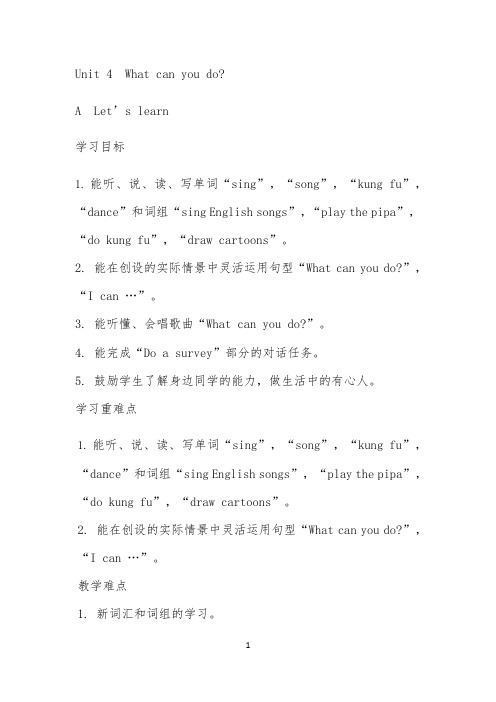
Unit 4 What can you do?A Let’s learn学习目标1.能听、说、读、写单词“sing”,“song”,“kung fu”,“dance”和词组“sing English songs”,“play the pipa”,“do kung fu”,“draw cartoons”。
2. 能在创设的实际情景中灵活运用句型“What can you do?”,“I can …”。
3. 能听懂、会唱歌曲“What can you do?”。
4. 能完成“Do a survey”部分的对话任务。
5. 鼓励学生了解身边同学的能力,做生活中的有心人。
学习重难点1.能听、说、读、写单词“sing”,“song”,“kung fu”,“dance”和词组“sing English songs”,“play the pipa”,“do kung fu”,“draw cartoons”。
2. 能在创设的实际情景中灵活运用句型“What can you do?”,“I can …”。
教学难点1. 新词汇和词组的学习。
2. 能在创设的实际情景中灵活运用句型“What can you do?”,“I can …”。
教学过程Step1 Warm-up1. Free talkT: Good morning, everyone. Welcome back to school. How are you today?Ss: Fine, thank you. And you?T: I’m fine, too. Are you ready for our class?Ss: Yes.2. 热身活动T: Now let’s do some warming-up practice. All of you, listen to me, please. Stand up and follow me. Run, I can run (read, jump, swim, fly, clean, draw …).Step2 Preview学习歌曲“What can you do?”T: You can jump, run, swim … You’re so great. Now let’s learn a song called “What can you do?”.第一次播放歌曲录音,全班学生跟着录音唱歌曲。
PEP五年级英语what_can_you_do

she/he
your mother/father What can do
Tom /lily
Miss Wang
panda/monkey/rabbit
I My mother/father Tom /lily Robot Panda can/can’t
wash the clothes
water the flowers
1、What can you do? -___ A、I'm helpful B、I like apples C、I can cook the meals 2、-___?-I can sweep the floor. A、What can you do? B、What’s she like? C、What day is it today? 3、What can you do?-I can_the floor. A、clean B、water C、empty 4、What can she do?-_can empty the trash. A、He B、She C、I 5、Can you water the flowers?-Yes,___. A、I can B、I am C、I do
What can you do? can do 能够,可以
做,干
你可以做什么?
help helpful
帮助 有帮助的,有用的
I’m helpful.
我是有帮助的。
Are you helpful at home? at home 在家里
你在家里面有帮助吗?
Yes ,I am. Sure. 当然
you
你可以做什么? I can water the flower.
我可以浇花。
empty the trash
Unit4 What can you do (单元解读) -五年级英语上册(人教PEP版)

五上Unit 4 What can you do? 单元解读一、单元信息二、单元内容:本单元属于“人与自我”“人与社会”的主题,是个人、家庭、社区及学校生活的语境,与学生的休闲学习生活联系密切。
要求学生能简单介绍自己会的运动或特长,谈论在运动、生活等方面能做什么不能做什么。
根据课标要求,通过本单元学习,学生能在具体情境中真实的表达自己的能力,发现自己的能力短板以及和同学之间的能力差异,并能根据自身特点和不足交朋友,学会团队合作。
认同自我,认同他人,形成积极向上的学习和生活态度.三.教材分析:本单元围绕话题“What can you do?(你能做什么?) 引出两组情景对话、一篇小阅读和一个趣味故事,目的是让学生运用句型询问他人的能力及介绍自己的能力,并在此基础上培养学生的语言交际能力和“用英语做事情”的能力。
本单元的内容与日常生活息息相关,容易激发学生的学习兴趣。
本单元在复习以前学过的一些表示动作的词汇的基础上,注重名词和动词词组的搭配使用,并在不同的情景下理解情态动词can 的正确使用,学会独立运用“What can you do?”“ I can..”“Can you···?”“ Yes, I can.”等功能语句进行语言交际,解决现实生活中关于此类话题的问题,并培养学生“I can do it.”的主人翁精神。
本单元主要分为 A、B、C 三个部分。
A 部分包括重点词汇和情景对话,主要内容为学习有关课余文化活动的词汇,并展开完成询问他人的能力及介绍自己能力的交际,分三个课时。
第一课时,通过Miss White 和张鹏以及John 的对话引出动词短语sing English songs,do some kungfu 及词汇next Tuesday 和we'1l,学习句型What can you do? I can...第二课时,通过Miss White 和Mike 的对话以及学生参与不同课余文化活动学习动词及动词词组dance, sing English songs, do kung fu, play the pipa, draw cartoons,继续学习和巩固询问他人的能力及介绍自己的能力的句型。
Unit4 What can you do

Unit4 What can you do?一.单词sing 唱;唱歌song 歌曲sing English song 唱英文歌曲play the pipa 弹琵琶kung fu 功夫;武术do kung fu 练武术dance 跳舞draw 画cartoon 漫画draw cartoons 画漫画cook 烹调;烹饪swim 游泳play basketball 打篮球ping-pong 乒乓球play ping-pong 打乒乓球speak English 说英语二、重点句子1. 我能为某事/某人做些什么如何表述:结构:—What can I do for + 某人/某物?—I can + 动词原形+ 其他。
eg. —What can I do for the party?—I can sing English songs.2. 如何询问你会…..及其回答:结构:—Can you do + 某事?—Yes,I can. / No, I can’t.eg. —Can you play ping-pang?—A little.3. can 是情态动词,没有人称和数的变化,后接动词原形。
变一般疑问句时将can放在句首,变否定句在can后加not,即can’t。
Eg: He can sweep the floor.(T)He cans sweep the floor (F)He can sweeps the floor. (F)我会扫地:I _____ ______ ______ _______她会倒垃圾:She _____ _____ _____ ______2. 变一般疑问句时将can放在句首,肯定回答:Yes, 主语+ do/否定回答:No, 主语+ don’t.变否定句在can后加not,即can’t。
Eg: He can count insects .(改为一般疑问句)_____ ______ ______ ________ ?肯定回答:_______________They can clean the livingroom. (改为否定句)_______ _______ clean the livingroom练习:(1)I can (do) the dishes.(2) He can (play)football..(3) We can cook the meals.(改一般疑问句,并作肯定回答)) ________(4) She can water the flowers.(改否定句)__________三、课程学习:1.1.讲P36-37(1)、主要掌握如何询问你能为某事/某人做些什么及其回答:(句子会读,会背)eg. —What can you do for the party?—I can play the pipa.(2 )、Wonderful! 非常好!(3)、如何询问你会做…..及其回答:eg. —Can you play ping-pang?—A little. (一点点。
Unit4-What-can-you-do教学设计
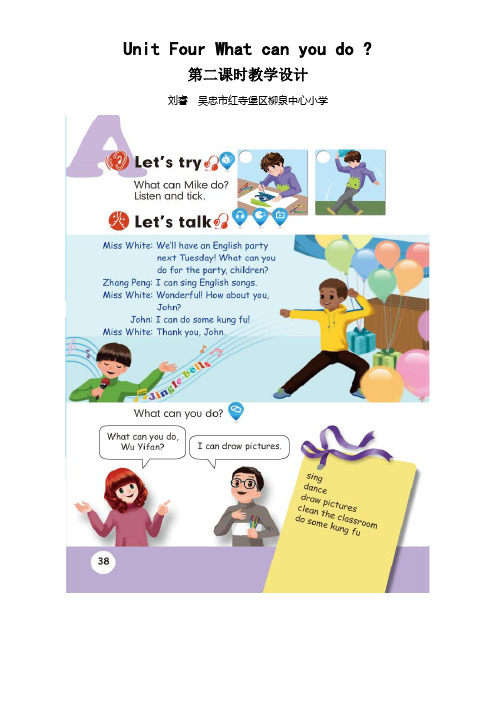
Unit Four What can you do ?第二课时教学设计刘睿吴忠市红寺堡区柳泉中心小学一、教学内容PEP 小学英语五年级上册Unit Four What can you do ?Part A Let’s try , Let’s talk.二、学情分析学生三年级学过情态动词can句型How many kites can you see ? I can see…对它们的表述有印象,相对而言,有必然的知识储蓄,故能够在温习的基础上将知识面拓展开一些,容量稍大点。
本单元的教学内容与学生的实际生活息息相关,因此本课时的教学内容对学生来讲不难明白得。
关键是日常交际用语在实际生活中的准确运用,而且小学生有着爱仿照,好表现的特点,只要在教学时,通过创设情景,游戏等形式提高反复率,从而就能够帮忙学生准确表达。
三、教材分析那个单元要紧围绕情态动词can展开话题,重点是使学生把握能做的一些情形的英语表达,并就此展开相关讨论。
学生三年级学过情态动词can.句型How many kites can you see ? I can see…因此咱们能够借助学生已有的知识来引出咱们的新知识,从而利于教学的开展,对学生来讲要把握句型并非是难点,难点应该是综合运用已学过的句型进行交流。
本课时是《义务教育课程标准实验教科书英语(PEP)》(供三年级起利用)五年级上册第四单元第二课时的教学内容,这部份内容有Let’s try , Let’s talk两个部份,重点要把握句型We’ll have an English party next Tuesday ! What can you do for the party ? 并能依照问句进行回答。
为学生进入初中时期与此类似的话题的学习打下扎实的基础。
并在此基础之上培育学生英语表达能力,能够对自己能做的情形进行自如表达。
因此,在教学进程中,教师应尽可能运用直观教学手腕,比如:图片、动画、歌曲等方式帮忙学生进行学习。
Whatcanyoudo设计 -完整版教学设计
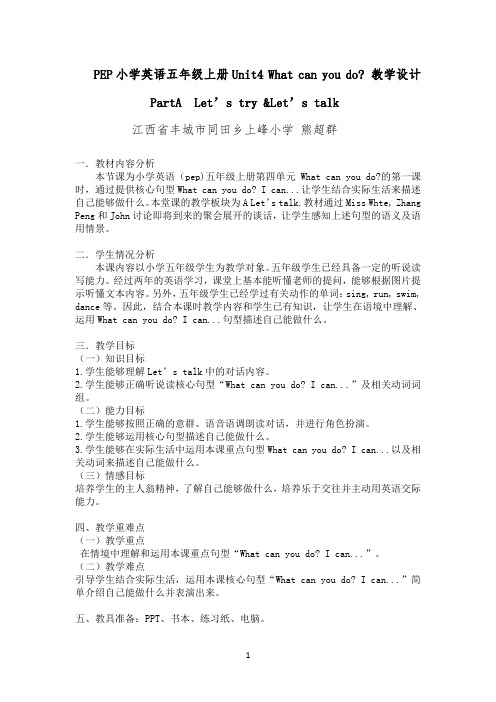
PEP小学英语五年级上册Unit4What can you do? 教学设计PartA Let’s try &Let’s talk江西省丰城市同田乡上峰小学熊超群一.教材内容分析本节课为小学英语(pep)五年级上册第四单元What can you do?的第一课时,通过提供核心句型What can you do? I can...让学生结合实际生活来描述自己能够做什么。
本堂课的教学板块为A Let’s talk.教材通过Miss Whte, Zhang Peng和John讨论即将到来的聚会展开的谈话,让学生感知上述句型的语义及语用情景。
二.学生情况分析本课内容以小学五年级学生为教学对象。
五年级学生已经具备一定的听说读写能力。
经过两年的英语学习,课堂上基本能听懂老师的提问,能够根据图片提示听懂文本内容。
另外,五年级学生已经学过有关动作的单词:sing, run, swim, dance等。
因此,结合本课时教学内容和学生已有知识,让学生在语境中理解、运用What can you do? I can...句型描述自己能做什么。
三.教学目标(一)知识目标1.学生能够理解Let’s talk中的对话内容。
2.学生能够正确听说读核心句型“What can you do? I can...”及相关动词词组。
(二)能力目标1.学生能够按照正确的意群、语音语调朗读对话,并进行角色扮演。
2.学生能够运用核心句型描述自己能做什么。
3.学生能够在实际生活中运用本课重点句型What can you do? I can...以及相关动词来描述自己能做什么。
(三)情感目标培养学生的主人翁精神,了解自己能够做什么,培养乐于交往并主动用英语交际能力。
四、教学重难点(一)教学重点在情境中理解和运用本课重点句型“What can you do? I can...”。
(二)教学难点引导学生结合实际生活,运用本课核心句型“What can you do? I can...”简单介绍自己能做什么并表演出来。
what can you do
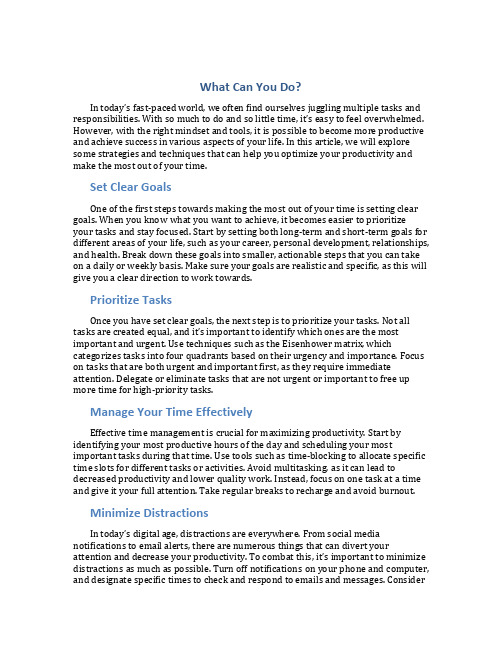
What Can You Do?In today’s fast-paced world, we often find ourselves juggling multiple tasks and responsibilities. With so much to do and so little time, it’s easy to feel overwhelmed. However, with the right mindset and tools, it is possible to become more productive and achieve success in various aspects of your life. In this article, we will explore some strategies and techniques that can help you optimize your productivity and make the most out of your time.Set Clear GoalsOne of the first steps towards making the most out of your time is setting clear goals. When you know what you want to achieve, it becomes easier to prioritize your tasks and stay focused. Start by setting both long-term and short-term goals for different areas of your life, such as your career, personal development, relationships, and health. Break down these goals into smaller, actionable steps that you can take on a daily or weekly basis. Make sure your goals are realistic and specific, as this will give you a clear direction to work towards.Prioritize TasksOnce you have set clear goals, the next step is to prioritize your tasks. Not all tasks are created equal, and it’s important to identify which ones are the most important and urgent. Use techniques such as the Eisenhower matrix, which categorizes tasks into four quadrants based on their urgency and importance. Focus on tasks that are both urgent and important first, as they require immediate attention. Delegate or eliminate tasks that are not urgent or important to free up more time for high-priority tasks.Manage Your Time EffectivelyEffective time management is crucial for maximizing productivity. Start by identifying your most productive hours of the day and scheduling your most important tasks during that time. Use tools such as time-blocking to allocate specific time slots for different tasks or activities. Avoid multitasking, as it can lead to decreased productivity and lower quality work. Instead, focus on one task at a time and give it your full attention. Take regular breaks to recharge and avoid burnout.Minimize DistractionsIn today’s digital age, distractions are everywhere. From social media notifications to email alerts, there are numerous things that can divert your attention and decrease your productivity. To combat this, it’s im portant to minimize distractions as much as possible. Turn off notifications on your phone and computer, and designate specific times to check and respond to emails and messages. Considerusing productivity apps or browser extensions that block access to distracting websites during work hours. Create a dedicated workspace that is free from distractions to help you stay focused.Take Care of YourselfTaking care of your physical and mental well-being is essential for maintaining productivity and achieving success. Make sure you get enough sleep, eat a balanced diet, and engage in regular exercise. Prioritize self-care activities such as meditation or hobbies that help you relax and recharge. Set boundaries and learn to say no when necessary to avoid overcommitting yourself. Practice stress management techniques such as deep breathing or mindfulness to reduce stress and improve focus.Continual Learning and ImprovementFinally, strive for continual learning and improvement. The world is constantly evolving, and it’s important to stay updated and adapt to new technologies and trends. Set aside time for learning new skills or acquiring knowledge in your field. Seek feedback from others and be open to constructive criticism. Embrace challenges and view them as opportunities for growth. Cultivate a growth mindset and always be curious and willing to explore new possibilities.In conclusion, by setting clear goals, prioritizing tasks, managing time effectively, minimizing distractions, taking care of yourself, and embracing continual learning, you can optimize your productivity and make the most out of your time. Remember that productivity is not just about working harder, but also about working smarter. With the right strategies and mindset, you can achieve success and fulfillment in various aspects of your life. So, what are you waiting for? Start implementing these strategies today and unlock your full potential.。
- 1、下载文档前请自行甄别文档内容的完整性,平台不提供额外的编辑、内容补充、找答案等附加服务。
- 2、"仅部分预览"的文档,不可在线预览部分如存在完整性等问题,可反馈申请退款(可完整预览的文档不适用该条件!)。
- 3、如文档侵犯您的权益,请联系客服反馈,我们会尽快为您处理(人工客服工作时间:9:00-18:30)。
Sing a song
I can sing
Class is over.
Thanks for your coming.
Say a rhyme
Run run run I can run.
Su Hai can sing.
Say a rhyme
Sing sing sing I can sing.
Helen can dance.
Say a rhyme Dance dance dance I can dance.
Boys and girls. Let’s play a game. OK ?
Can you row a boat?
No, I can’t.
快速说单词
dance
sing
fly a kite row a boat
练习根据实际情况用“yes,I can.” or ‘‘No,I
can’t.” 回答。
Can you speak English? Yes,I can. Can you sing? Yes,I can. Can you run? Yes,I can. Can you dance? No,I can’t. Can you row a boat? No,I can’t. Can you fly a kite? No,Ican’t.
Let’s chant and do .
• Fly fly like a bird.
• Swim swim like a fish. • Run run like a horse.
What can you do?
I can ……. Can you ……?
What can HanHong do? HanHong can sing
Can you sing?
Yes, I can.
What can she do? She can dance.
Can you dance? Yes, I can.
What can he do?
He can fly a kite. Can you fly a kite? No, I can’t. He can row a boat.
What can you do?
Say a rhyme
Follow me
Hands up! Hands down! Follow me, And turn around.
Say and do
Touch your nose. Touch your mouth.
Touch your eye.
Hello!My name is robot.
Hello,I’m Mike. I can do many things.
Mike can jump.
Can you jump?
Say a rhyme
Jump jump jump I can jump.
Helloபைடு நூலகம்I’m Wang Bing.
Can you run? I can run.
